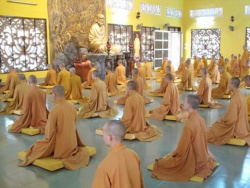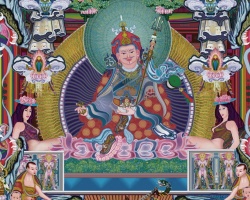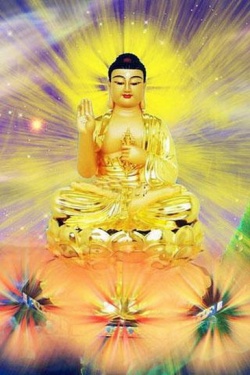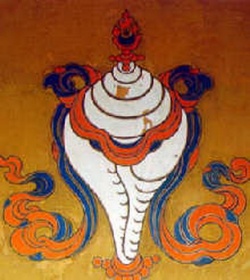Creation Stories: The Cosmogony Account from the Buddhist Tantras
<poem>
By David Reigle on December 25, 2013 at 11:57 pm
The standard Buddhist account of cosmogony shows the world arising from the collective karma or actions of living beings in the form of a primordial wind (vāyu). This account is based on the Buddhist sūtras, and was formulated in the Abhidharma texts. Another account, based on the Buddhist tantras, shows the world arising from the clear light or luminosity (prabhāsvara, ’od gsal), which is the nature of mind (citta-prakṛti). The Book of Dzyan is said to be the first volume of commentaries on the secret Books of Kiu-te]] (rgyud sde), i.e., the Buddhist tantras. So we might expect its cosmogony account to be closer to that from the known Buddhist tantras than to that from the Buddhist sūtras. In the Book of Dzyan (stanza 3, verse 3), the actual moment of manifestation is described with the words, “darkness radiates light.” In the Buddhist tantras, too, the world arises from light, the clear light or luminosity (prabhāsvara). This cosmogony was concisely formulated by Āryadeva in only four verses. These were often quoted in other tantric texts as what seems to have become the standard account of cosmogony and dissolution from the Buddhist tantras, specifically the so-called “highest yoga” tantras.
Āryadeva is regarded as the spiritual son of Nāgārjuna. Nāgārjuna wrote the Pañca-krama, the “Five Stages,” describing the completion stage practices of the Guhyasamāja-tantra. The Guhyasamāja-tantra is one of the most central of the “highest yoga” tantras in Buddhism. The third of its five completion stage practices is called svādhiṣṭhāna, “self-blessing” or “self-consecration.” On this, Āryadeva wrote a short treatise called the Svādhiṣṭhāna-krama-prabheda, or just Svādhiṣṭhāna-prabheda. The four verses giving the Buddhist tantric account of cosmogony are verses 18-21 of this treatise. The original Sanskrit text of the Svādhiṣṭhāna-prabheda was found and was first published in Dhīḥ: A Review of Rare Buddhist Texts, vol. 10, 1990, pp. 20-24. It was reprinted along with its Tibetan translation in Bauddhalaghugrantha Samgraha, edited by Janardan Pandey, Central Institute of Higher Tibetan Studies, 1997, pp. 169-194. The four verses on cosmogony were quoted in the Sekoddeśa-ṭīkā, a Kālacakra work: 1941 edition by Mario E. Carelli, pp. 51-52; 2006 edition by Francesco Sferra, pp. 150-151. As there noted by Sferra, they were also quoted in the Amṛtakaṇikodyota commentary on the Mañjuśrī-nāma-saṃgīti, edited by Banarsi Lal, 1994, p. 165, and in the Pañcakrama-ṭippaṇī of Muniśrībhadra, edited by Zhongxin Jiang and Toru Tomabechi, 1996, p. 58.
From these texts I have prepared a Sanskrit edition of Āryadeva’s four verses on cosmogony, giving variant readings, and have translated these verses into English. They explain more fully what was said in a verse from the svādhiṣṭhāna chapter of Nāgārjuna’s Pañcakrama, which I cite and translate first. There are no variants for this verse in the three Sanskrit editions: the 1896 edition by L. de la Vallée Poussin, the 1994 edition by Katsumi Mimaki and Tōru Tomabechi, and the 2001 edition by Ram Shankar Tripathi. It is Pañcakrama, chapter 3, verse 15:
asvatantraṃ jagat sarvaṃ svatantraṃ naiva jāyate |
hetuḥ prabhāsvaraṃ tasya sarva-śūnyaṃ prabhāsvaram ||
“The entire world is dependent [on a cause), for something independent can never arise. Its [the world’s] cause is luminosity (prabhāsvara); luminosity is the universal void (sarva-śūnya).”
Āryadeva’s four verses on cosmogony from the Svādhiṣṭhāna-prabheda that explain this more fully are:
prabhāsvarān mahā-śūnyaṃ tasmāc copāya-sambhavaḥ |
tasmād utpadyate prajñā tasyāḥ pavana-sambhavaḥ || 18 ||
18. From luminosity (prabhāsvara) [arises] the great void (mahā-śūnya), and from that is the arising of means (upāya). From that, wisdom (prajñā) is arisen. From that is the arising of air.
pavanād agni-sambhūtir agneś ca jala-sambhavaḥ |
jalāc ca jāyate pṛthvī sattvānām eṣa sambhavaḥ || 19 ||
19. From air is the arising of fire, and from fire is the arising of water; and from water, earth is born. This is the arising of living beings.
bhū-dhātur līyate toye toyaṃ tejasi līyate |
tejaś ca sūkṣma-dhātau ca vāyuś citte vilīyate || 20 ||
20. The earth element dissolves in water. Water dissolves in fire, and fire in the subtle element (air). Air dissolves in mind (citta).
cittaṃ caitasike līyetāvidyāyāṃ tu caitasam |
sāpi prabhāsvaraṃ gacchen nirodho ’yaṃ bhava-traye || 21 ||
21. Mind will dissolve in the mental derivatives (caitasika), and the mental derivatives in ignorance (avidyā). This, too, will go to luminosity (prabhāsvara). That is the cessation of the triple world.
As may be deduced from the fact that these verses are given or quoted in “highest yoga” tantra texts, this account of the creation and dissolution of the world from and into prabhāsvara, luminosity or clear light, is correlated to advanced yogic practice. Āryadeva’s concise four verses provide what seems to have been taken as the most representative statement on cosmogony as understood in the Buddhist “highest yoga” tantras. This cosmogony was discussed further in a number of other tantric texts from the standpoint of tantric practice. Very few of these texts have yet been translated into English.
The cosmogony account showing the world arising from the collective karma or actions of living beings in the form of a primordial wind (vāyu), based on the Buddhist sūtras, and the cosmogony account showing the world arising from the clear light or luminosity (prabhāsvara, ’od gsal) that is the nature of mind (citta-prakṛti), based on the Buddhist tantras, need not be taken as conflicting alternative accounts. The latter account can be seen as simply going a little further back. According to Buddhism, karma is not just action per se but rather is volitional action, and there can be no volitional action without mind. So the nature of mind, luminosity, must be there for karma to occur.
Furthermore, the tantric texts that discuss this cosmogony of the luminosity or clear light nature of mind normally do so in association with the subtle winds or airs. The teaching is that mind or consciousness rides on the winds as its mount (vāhana). This is apparently the same teaching given in Book of Dzyan, stanza 5, verse 2: “Fohat is the steed and the thought is the rider.” Fohat, the “fiery whirlwind,” is closely parallel to the primordial wind that forms the world in the karmic wind cosmogony. The two Buddhist cosmogony accounts appear to be the two parts of a single cosmogony, much like the one given more fully in the Book of Dzyan.
Variant readings:
18b: śūnyāc for tasmāc, SṬ1, SṬ2, AKU.
18c: upāyāj jāyate prajñā, AKU.
19b: ca is omitted, PKṬ.
19c: jalāj jāyate pṛthivī, SṬ1, SṬ2.
19d: bhavāṅgānām ayaṃ nayaḥ, AKU.
20a: pṛthivī līyate toye, AKU.
20b: toyas tejasi, SP1, SP2.
21a: cittaś caitasike, SP1, SP2.
21ab: līyed avidyāyāṃ, AKU, PKṬ.
21b: cetasam for caitasam, SP1, SP2, AKU.
21c: so ’pi for sāpi, SP1, SP2.
Abbreviations:
AKU = Amṛtakaṇikodyota.
PKṬ = Pañcakrama-ṭippaṇī of Muniśrībhadra.
SP1 = Svādhiṣṭhāna-prabheda, 1990 edition.
SP2 = Svādhiṣṭhāna-prabheda, 1997 edition.
SṬ1 = Sekoddeśa-ṭīkā, 1941 edition.
SṬ2 = Sekoddeśa-ṭīkā, 2006 edition.





